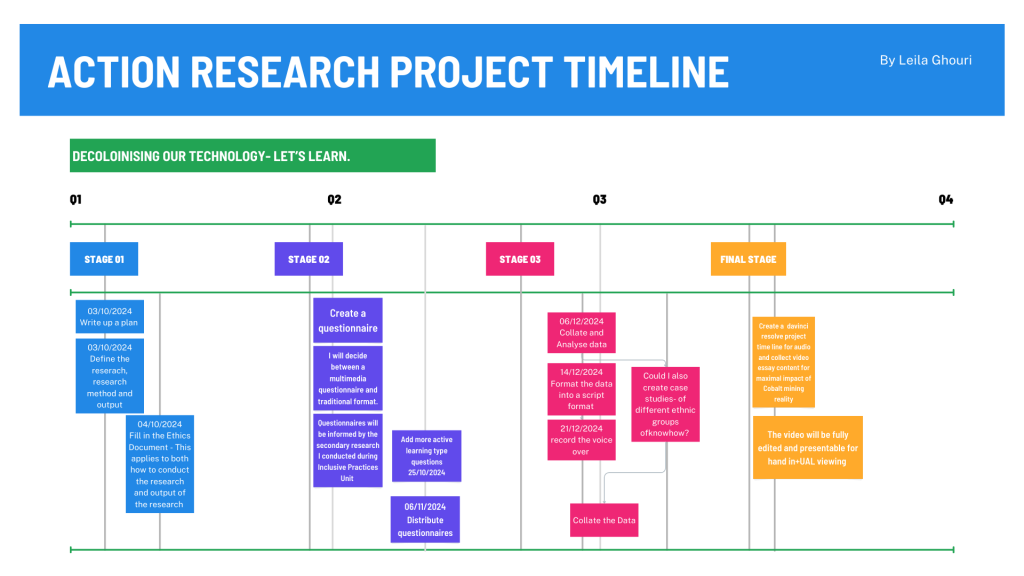I am pleased to share significant progress on my action research project. After revising my plan to incorporate critical feedback from my tutor, John O’Reilly, I have successfully resubmitted it and received approval to proceed. This marks a crucial step forward, and I am eager to advance into the next stages of the research.
One of the most important points raised by John was the necessity of addressing the ethics of utilising video materials sourced from platforms like YouTube and other documentaries. His feedback emphasised the importance of evaluating how such usage aligns with fair use policies, if at all. This insight has been integrated into the ethical framework of my research plan, strengthening its academic rigour and accountability.
Below I have included my revised resubmissions.
The questionnaire is still in development, with plans to deploy it using Microsoft Forms. I am currently exploring design enhancements, such as rating scales and Likert scales, to ensure alignment with the study’s objectives. I am also interested in assessing participants’ perspectives on the use of video essays as a form and as a means of disseminating information—a topic that could yield valuable insights into this medium’s effectiveness.
This iterative process continues to enrich my understanding, and I look forward to sharing further developments.
Video essays have become a powerful tool for communicating complex research topics to broad audiences. As a video essayist myself, passionate about ethics, economy, and environmental sustainability, my Action research project examines the contentious issue of cobalt mining. With its essential role in powering rechargeable batteries, cobalt mining is a global necessity fraught with challenges. To ensure my video essay is grounded in real-world understanding, I am designing a questionnaire to capture the perspectives of those who engage with video essays, and benefit from cobalt mining, but are not necessarily directly impacted by the latter.
Creating a questionnaire mirrors the process of crafting a video essay. Both require a clear purpose, structured design, and audience awareness. I have 2 goals, 1. to find out how staff and students engage with Video Essays if at all. This would include questions based on the length, content and narration, and all other components of a video essay. 2. Is to explore if participants are aware of the climate and social justice issues associated to cobalt mining. Questions will address working conditions and ethical concerns in supply chains. Both findings will aid in shaping the video’s content, length and tone, whether it leans toward advocacy or exploration.
Taherdoost’s (2022) guide on questionnaire design provides a framework for this project. A quasi-structured format, blending close-ended questions for quantitative insights and open-ended ones for personal narratives, is ideal. For instance, participants might rate effectiveness of video essays on a scale while sharing feelings towards cobalt mining. These narratives will add a democratic and emotional depth to the video essay, connecting data to real life human experiences. I will be using the Self administered technique in order to gain a larger sample size
The clarity of question wording is critical, as is the organisation of questions. I intend to avoid ambiguous or poorly framed questions. Vague inquiries about mining’s harm, must be avoided. The questionnaire, like the video’s narrative, will follow a “funnel approach,” beginning with general questions on video essays and progressing to specific, sensitive topic of cobalt mining. This structure helps to builds rapport and enhances engagement.
The final video essay will integrate data from the questionnaire, footage of cobalt mines, and interviews to present a balanced and evocative narrative. By combining academic rigour with storytelling, the project aims to inform viewers and amplify the trials and tribulations of those central to the cobalt mining industry and shedding light on this complex issue, and relating it to our portable technology which uses cobalt.
Please find my ARP time line below

(word count 633)
References
Currently I am reading materials on questionnaire design:
Krosnick, J. A. and Presser, S., 2009. Question and Questionnaire Design. In: J.D. Wright and P.V. Marsden, eds. Handbook of Survey Research. 2nd ed. San Diego, CA: Elsevier.
Saris, W. E., Revilla, M., Krosnick, J. A. and Shaeffer, E. M., 2010. Comparing Questions with Agree/Disagree Response Options to Questions with Item-Specific Response Options. Survey Research Methods, 4(1), pp. 61-79.
Taherdoost, H., 2022. Designing a Questionnaire for a Research Paper: A Comprehensive Guide to Design and Develop an Effective Questionnaire. Asian Journal of Managerial Science, 11(1), pp. 8-16. DOI: https://doi.org/10.51983/ajms-2022.11.1.3087.